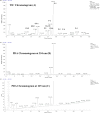Profiling of glucosinolates and flavonoids in Rorippa indica (Linn.) Hiern. (Cruciferae) by UHPLC-PDA-ESI/HRMS(n)
- PMID: 24893216
- PMCID: PMC4082396
- DOI: 10.1021/jf405538d
Profiling of glucosinolates and flavonoids in Rorippa indica (Linn.) Hiern. (Cruciferae) by UHPLC-PDA-ESI/HRMS(n)
Abstract
An UHPLC-PDA-ESI/HRMS(n) profiling method was used to identify the glucosinolates and flavonoids of Rorippa indica (Cruciferae), a wild vegetable and Chinese herb used to treat cough, diarrhea, and rheumatoid arthritis. Thirty-three glucosinolates, more than 40 flavonol glycosides, and 18 other phenolic and common organic compounds were identified. The glucosinolates and polyphenols were separated by UHPLC. High-resolution deprotonated molecules provided high accuracy mass values that were used to determine formulas and provide putative identification of the glucosinolates and flavonoids. The fragments from multistage mass spectrometry were used to elucidate the structures. The concentrations of the main components were based on UV peak areas and molar relative response factors with a single calibration standard. This study found this plant to be a rich source for glucosinolates, containing 24 new glucosinolates, including 14 glucosylated glucosinolates that were previously unidentified.
Figures





Similar articles
-
Profiling polyphenols in five Brassica species microgreens by UHPLC-PDA-ESI/HRMS(n.).J Agric Food Chem. 2013 Nov 20;61(46):10960-70. doi: 10.1021/jf401802n. Epub 2013 Nov 5. J Agric Food Chem. 2013. PMID: 24144328 Free PMC article.
-
Naturally occurring glucosinolates in plant extracts of rocket salad (Eruca sativa L.) identified by liquid chromatography coupled with negative ion electrospray ionization and quadrupole ion-trap mass spectrometry.Rapid Commun Mass Spectrom. 2007;21(14):2374-88. doi: 10.1002/rcm.3101. Rapid Commun Mass Spectrom. 2007. PMID: 17590871
-
An integrated analytical approach based on enhanced fragment ions interrogation and modified Kendrick mass defect filter data mining for in-depth chemical profiling of glucosinolates by ultra-high-pressure liquid chromatography coupled with Orbitrap high resolution mass spectrometry.J Chromatogr A. 2021 Feb 22;1639:461903. doi: 10.1016/j.chroma.2021.461903. Epub 2021 Jan 13. J Chromatogr A. 2021. PMID: 33486443
-
In Vitro and In Vivo Antioxidant Activities of the Flowers and Leaves from Paeonia rockii and Identification of Their Antioxidant Constituents by UHPLC-ESI-HRMSn via Pre-Column DPPH Reaction.Molecules. 2018 Feb 12;23(2):392. doi: 10.3390/molecules23020392. Molecules. 2018. PMID: 29439520 Free PMC article.
-
Determination of glucosinolates in traditional Chinese herbs by high-performance liquid chromatography and electrospray ionization mass spectrometry.Anal Bioanal Chem. 2006 Dec;386(7-8):2225-32. doi: 10.1007/s00216-006-0882-7. Epub 2006 Nov 4. Anal Bioanal Chem. 2006. PMID: 17086388
Cited by
-
Analysis of Processing Effects on Glucosinolate Profiles in Red Cabbage by LC-MS/MS in Multiple Reaction Monitoring Mode.Molecules. 2021 Aug 26;26(17):5171. doi: 10.3390/molecules26175171. Molecules. 2021. PMID: 34500612 Free PMC article.
-
Mass spectrometric evidence for the modification of small molecules in a cobalt-60-irradiated rodent diet.J Mass Spectrom. 2017 Aug;52(8):507-516. doi: 10.1002/jms.3950. J Mass Spectrom. 2017. PMID: 28544323 Free PMC article.
-
Dual-locus DNA metabarcoding reveals southern hairy-nosed wombats (Lasiorhinus latifrons Owen) have a summer diet dominated by toxic invasive plants.PLoS One. 2020 Mar 6;15(3):e0229390. doi: 10.1371/journal.pone.0229390. eCollection 2020. PLoS One. 2020. PMID: 32142513 Free PMC article.
-
Importance of Accurate Measurements in Nutrition Research: Dietary Flavonoids as a Case Study.Adv Nutr. 2016 Mar 15;7(2):375-82. doi: 10.3945/an.115.010470. Print 2016 Mar. Adv Nutr. 2016. PMID: 26980821 Free PMC article. Review.
-
Chemical Profiling, Antioxidant, Cytotoxic Activities and Molecular Docking Simulation of Carrichtera annua DC. (Cruciferae).Antioxidants (Basel). 2020 Dec 16;9(12):1286. doi: 10.3390/antiox9121286. Antioxidants (Basel). 2020. PMID: 33339242 Free PMC article.
References
-
- Halkiel B. A.; Gershenzon J. Biology and biochemistry of glucosinolates. Annu. Rev. Plant Biol. 2006, 57, 303–333. - PubMed
-
- Johnson I. T. Glucosinolates: bioavailability and importance to health. Int. J. Vitam. Nutr. Res. 2002, 72, 26–31. - PubMed
-
- Dinkova-Kostova A. T.; Rumen V.; Kostov R. T. Glucosinolates and isothiocyanates in health and disease. Trends Mol. Med. 2012, 18, 337–347. - PubMed
-
- Fahey J. W.; Zalcmann A. T.; Talalay P. The chemical diversity and distribution of glucosinolates and isothiocyanates among plants. Phytochemistry 2001, 6, 5–51. - PubMed
-
- Agerbirk N.; Olsen C. E. Glucosinolate structures in evolution. Phytochemistry 2012, 77, 16–45. - PubMed
Publication types
MeSH terms
Substances
LinkOut - more resources
Full Text Sources
Other Literature Sources

